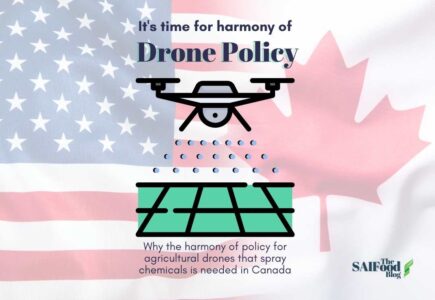Harmony of policy across borders
The harmonization of regulations between neighbouring countries makes everything easier. It is vital to ensure that identical products and technologies are assessed for potential risks using identical risk assessment methodologies, especially when the same product is being sold in both countries. The harmonization of policy allows the technology developer to submit the same package of evidence to each regulatory authority, helping to lower the cost of commercialization. If the same product is cheaper on the other side of the border, it creates negative economic impacts as consumers will order it online or drive across the border to the product, which reduces demand and jobs in their own country. Harmonization also ensures that adopters on one side of an international border don’t gain production efficiencies over those on the other side, which allows them to be more competitive and hence more profitable. The importance of regulatory harmonization is included in virtually all international trade agreements, to lower and/or remove regulatory barriers to innovative products and technologies.
Technology advances in spray applications
When it comes to harmonization, there is a particular area in agriculture, which in my opinion looks like a simple one to match that of our Southern neighbours. The area I speak of in agriculture is one that has witnessed substantial innovative efforts, chemical application technology. Historically, sprayers were designed with a boom containing nozzles that were evenly spaced, allowing for chemicals to be consistently applied across the entire field. As advances in electronics, robotics and digital technologies increased, we have reached the development of sprayer technology capable of ‘seeing’ weeds and then triggering the nozzle to directly target chemical application to only the weed became reality. Its success was realized when the developer of this technology, Blue River Technology, was acquired by John Deere five years ago for just over US$300 million. Such technology offered the potential to reduce chemical applications by over 90%. This technology is capable of spraying weeds in between defined crop rows but also spraying weeds growing within the row of the crop, by visual differentiating the leaves of weeds from those of the planted crop. The majority of weeds have leaf patterns considerably different from planted crops. The advantage of this technology has been its precision. The former tech couldn’t turn off nozzles, therefore a sprayer would spray large sections that didn’t need it, to control particular weeds.
Advancing from this precision nozzle technology has been the movement toward drones to spray crops. At present, drone sprayers aren’t yet capable of replacing large, high clearance sprayers, but are fully capable of spot spraying, spraying small areas that were missed by larger sprayers, and targeting difficult to kill weeds that may be growing within a crop, such as thistles. Drones could allow farmers to target weed issues without having to overspray areas or have to move the larger sprayer throughout the entire field. This alone is a big advantage to producers and a means to reduce greenhouse gas (GHG) emissions in the field. Its likely farmers will continue to use their large sprayers with precision nozzles, but if drones were to be approved, they could easily be used to spray smaller areas, reducing fuel use.
Bans on drones for crop spraying need to be removed
In Canada, the regulation of the use of drones for spraying falls under the domain of the Pest Management Review Agency (PMRA). The PMRA currently bans the use of drones for spray application. Given that this is a new technology being used to apply chemicals, technical and environmental questions exist as to how far the sprayed chemical may drift from a drone application and if the application of chemicals via this technology is consistent with previous technologies. Therefore, it has yet to be approved by the PMRA. There is also the issue that this aerial device, if not used properly, could be used to spray onto properties not owned by the operator. While we think this is unlikely to occur, regulations and procedures need to be established were this to happen. The PMRA is working with other regulatory agencies to gather evidence about the use of drones to expedite the approval of drones for spraying.
The use of drones for aerial spraying is a promising green technology, capable of further contributing to Canadian agriculture’s commitments to reducing GHG emissions. Innovation is fundamentally important for agriculture and farmers’ ability to use drones to spray represents very promising technology. While drones aren’t presently capable of spraying an entire field, as the technology advances, the potential exists for this to change in the next few years. Were farmers able to use drones to conduct all their spraying applications, it would reduce their fuel and chemical use.
Where is the drone harmony?
Before drones can be approved for chemical spraying, the PMRA must assess the risks from a chemical application by drones and approve this method of application as drone spraying. This risk assessment has already been completed and is legal in the USA. This gives American farmers an advantage over Canadian farmers in access to innovative technology, capable of increasing yield as it reduces the weed population. In the globally competitive crop production marketplace, Canadian farmers need to ensure they are as equally competitive as their American neighbours. The US has developed a framework for the use of drones for spraying that includes operation rules, training and licensing requirements, all of which will need to be determined by the PMRA. The reality is that drone spraying in the US is unlikely to differ from drone spraying in Canada and adopting the existing American policies and guidelines is an excellent opportunity to harmonize regulations.


